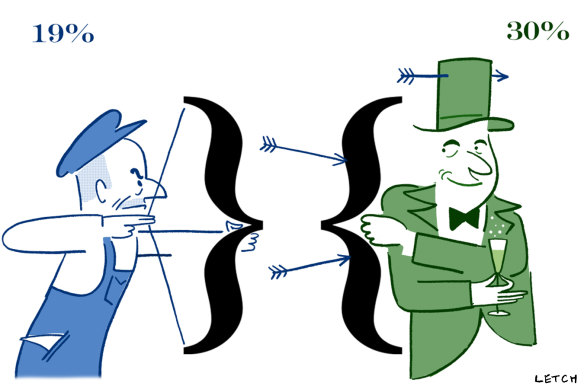The PM is set for a taxing backlash, and guess who’ll be leading the cry?
Save articles for later
Add articles to your saved list and come back to them any time.
Anthony Albanese, who never impressed me when a warrior of the NSW Labor Left, has impressed me greatly by the way he’s conducted himself since becoming prime minister. He wants to raise the standard of political behaviour. Everyone gets listened to with respect, and every election promise he made not to do this, and not to do that, is honoured, no matter how inconvenient.
Having lumbered himself with those promises, Albo is taking the long view. His first term will be used to win voters’ respect and trust, creating a foundation for him to be more comfortably re-elected, with a program of more controversial reform.
Leader of the Opposition Peter Dutton has Prime Minister Anthony Albanese in his sights.Credit: Rhett Wyman
Which brings us to the much-debated stage three tax cuts, designed by his political opponents to favour high-income earners at the expense of low and middle earners, something anathema to a Labor government but already put into law.
Many have been urging Albanese and his Treasurer Jim Chalmers to rescind the tax cuts or at least cut them back. But it now seems clear Albanese has made up his mind that the cut, no matter how deleterious, must go ahead. A clear promise was given, and must be kept. Can you imagine the outcry if it wasn’t? Peter Dutton would never let it rest.
Well, I can imagine it. But if Albanese thinks that keeping the promise will mean no outcry, he’s sadly deluded. Once the punters see how little they’re getting compared with how much the fat cats (including a particularly fat economics journo) are getting – once everyone sees the official “what-you-save tax table” published by every masthead – there’ll be a lot of anger.
And guess who’ll be leading the cry. Do you really think Dutton won’t have the front to turn on his own government’s tax cuts? He was trying it out in his budget reply speech last week: “Labor’s working poor”. How about “the struggling middle class”?
Illustration: Simon Letch. Credit:
Albanese needs to do two things: get Treasury to give him an advance look at that what-you-save table, and get some pollie with a better memory to remind him how “bracket creep” works and how resentful middle income-earners get when they see more and more of every pay rise disappearing in tax.
Because the income tax scale isn’t indexed for inflation, every pay rise you get increases the average rate of tax you pay on the whole of your income – whether or not it literally lifts you into a higher tax bracket. And because the brackets are closer together at the bottom of the scale, bracket creep hits lower incomes harder than middle incomes. But middle incomes are hit harder than high incomes because those people already in the top tax bracket can’t be pushed any higher.
Bracket creep gets greater as inflation increases. The inflation rate’s been unusually high, which has led to higher pay rises, even if they haven’t been big enough to match the rise in prices. Even so, your latest pay rise is having slightly more tax taken out of it than the previous one. So bracket creep is another, hidden reason you’re having trouble keeping up with the cost of living.
If we never got a tax cut, the average rate of tax we pay on all our income would just keep going up and up forever – unless, of course, we never got another pay rise.
This is why every government knows it must have a tax cut every few years if it wants to stop the natives getting restless. But the stage three tax cut we’re due to get from July next year hasn’t been designed to compensate people at the bottom, the middle and the top proportionately to the degree of bracket creep they’ve suffered since 2017-18, when the stage three tax cuts were announced.
Quite the reverse. According to estimates by Paul Tilley, a former Treasury officer, people earning up to roughly $70,000 a year will get tax cuts too small to fully reverse the rise in their average tax rate over the period.
Those earning between $70,000 and $120,000 a year will have their average tax rate cut back to what it was in 2018, whereas those earning more than that – that is, more than 1.5 times the median full-time wage – will get their average tax rate cut to well below what it was in 2018.
Now let’s look at what you save in dollars per week. Albanese says the tax cuts begin at $45,000 a year. The national minimum full-time wage is $42,250. So, people on very low wages, and many with part-time jobs, will get nothing.
On $55,000, you’ll get a saving of $2.40 a week. On the median full-time wage of about $80,000 you’ll get $16.80 a week – that is, no “real” saving. On $120,000, it’s $36 a week.
Meanwhile, me and my mates (and members of parliament), struggling to get by on $200,000 and above, will get a saving of $175 a week, or $25 a day.
Good luck selling that lot, Albo.
The Opinion newsletter is a weekly wrap of views that will challenge, champion and inform your own. Sign up here.
Most Viewed in Politics
From our partners
Source: Read Full Article

